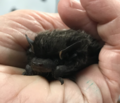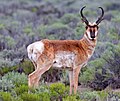
This is a list of mammals of Texas. Mammals native to or immediately off the coast of the U.S. state of Texas are listed first. Introduced mammals, whether intentional or unintentional, are listed separately.
Contents
- List of species
- Order Xenarthra
- Order Chiroptera
- Order Carnivora
- Order Artiodactyla
- Order Eulipotyphla
- Order Sirenia
- Order Didelphimorphia
- Order Lagomorpha
- Order Rodentia
- Order Cetacea
- Introduced/invasive mammals
- Order Primates
- Order Carnivora 2
- Order Artiodactyla 2
- Order Rodentia 2
- See also
- Notes and references
- Notes
- Citations
- External links
The varying geography of Texas, the second largest state, provides a large variety of habitats for mammals. The land varies from swamps, Piney Woods in the east, rocky hills and limestone karst in the central Hill Country of the Edwards Plateau, desert in the south and west, mountains in the far west (the Trans-Pecos), and grassland prairie in the north, also known as the Panhandle. [1] [2] [3] The state's many rivers, including the Rio Grande, the Colorado River, and the Trinity River, also provide diverse river habitats. [4] [5] Its central position in the United States means that species found primarily in either the western or eastern reaches of the country often have their ranges meeting in the state. Additionally, its proximity to Mexico is such that many species found there and into Central America also range as far north as Texas. [1]
Texas recognizes three official mammals: the nine-banded armadillo, the Texas Longhorn, and the Mexican free-tailed bat. State law protects numerous species. The state also recognizes the Texas State Bison Herd at Caprock Canyons State Park since 2011, [6] the state Longhorn herd at multiple state parks since 1969, [7] [6] and the state dog breed, Blue Lacy since 2005. [6]

















































































































